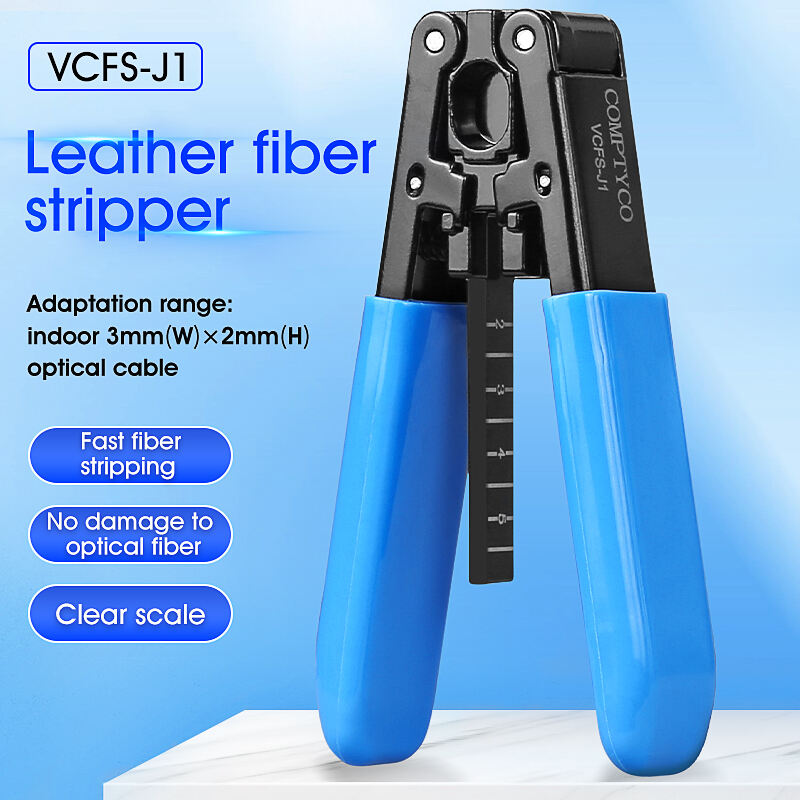Ошибки при применении лезвия и силы
Неправильный размер лезвия для покрытия волокном
Правильный размер лезвия имеет большое значение при снятии волокнистой облицовки. Когда кто-то выбирает правильное лезвие, он получает лучшие результаты, снимая покрытия из волокон, не нанося им вреда, что действительно влияет на то, как хорошо сигналы перемещаются через телекоммуникационные сети. Если лезвие на стриппинере слишком большое, оно может поцарапать само волокно, что приводит к значительным потерям сигнала. Мы видели много случаев, когда поврежденные волокна создают проблемы с качеством передачи по целой системе. Данные отрасли указывают, что около четверти всех проблем с отрывом волокон возникают из-за использования лопастей неправильного размера в телекоммуникационных работах. Поэтому техникам нужно обращать внимание на детали выбора лезвия, если они хотят, чтобы их системы связи работали плавно и надежно день за днем.
Чрезмерное применение силы при раздевании
Слишком большое давление - одна из тех ошибок, которые люди совершают постоянно, когда работают с волокнами, и это действительно всё портит. Когда кто-то применяет чрезмерную силу во время раздевания, он рискует разорвать волокно прямо там. Хуже того, даже если она не полностью сломается, волокно повреждается внутри, что означает, что в дальнейшем она будет работать не так хорошо. Большинство опытных техников скажут любому, кто послушает, что медленное и стабильное действие лучше всего подходит для операции с раздеванием. Они знают из опыта, что, если они не торопятся, то в конечном итоге сэкономить время, сохранив качество волокон. Некоторые исследования показали, что ошибка приводит к примерно на 30% большему количеству сбоев в установках волоконно-оптических сетей в разных отраслях. Если посмотреть на эти цифры, то понятно, почему для тех, кто работает с этими деликатными материалами, так важна надлежащая подготовка. Ведь никто не хочет иметь дело с дорогостоящими ремонтами, вызванными чем-то таким простым, как слишком большое давление.
Вопросы с длиной отсечения и удаления покрытия
Слишком много волокон
Когда техники снимают слишком много покрытия из оптических волокон, они совершают так называемое переодевание, что ослабляет волокно и влияет на его работу. Снятые участки становятся уязвимыми точками, которые часто ломаются во время монтажа или регулярной работы. Большинство отраслевых спецификаций рекомендуют снимать только 1 - 2 см покрытия, хотя точные измерения зависят от того, какую работу необходимо выполнять. Следуя этим основным правилам, волоконные волокна остаются достаточно крепкими, чтобы выполнять свое предназначение, не разрушаясь преждевременно. Проблемы в реальном мире возникают, когда люди переходят границы, снимая волокна. Находящиеся под воздействием веществ участки повреждаются влагой, пылью и изменениями температуры, которые впоследствии вызывают проблемы с сигналом. Техники, которые понимают, почему важно правильно снимать одежду, избегают создания таких проблемных мест.
Техники удаления несовместимого покрытия
Если кто-то не удаляет покрытия из волокон должным образом, они в конечном итоге получают неравные результаты, которые мешают тому, как хорошо сигналы проходят через кабель. Подумайте так: когда части покрытия остаются после удаления, оставшиеся биты создают проблемы для передачи данных по волоконному полю, делая соединения в лучшем случае ненадежными. Чтобы избежать этой головной боли, большинство профессионалов придерживаются определенных основ. Хорошей отправной точкой является получение правильно калиброванного инструмента для очистки волокон. Также важно, чтобы все было последовательно, от одного волокна к другому, на протяжении всей работы. TIA собрала довольно подробную документацию о правильных методах стриптинга, хотя многие опытные техники расскажут истории о том, как сначала научиться тяжелым способом, прежде чем проверить эти официальные рекомендации. Следование стандартным процедурам - это не просто соблюдение правил; это имеет смысл для всех, кто хочет, чтобы его волокно просуществовало дольше, не испытывая постоянных неполадок.
Не регулярно чистить лезвия
Регулярное уборка ножей для стриппировки волокон имеет решающее значение для их эффективности и долговечности. Когда лезвия грязны, они собирают пыль, грязь и липкие остатки от предыдущих работ, и это действительно мешает их способности делать работу правильно. Через некоторое время эти накопившиеся остатки начинают мешать при разборке, что означает, что происходит больше ошибок, чем должно. Исследования показывают, что здесь тоже есть что-то очень показательное: оборудование, на которое не обращают внимания, имеет тенденцию к проблемам с раздеванием примерно на 30 процентов чаще. Чтобы лучше всего очищать, возьмите качественное средство для чистки и мягкую кисть. Осторожно оттирайте эти упрямые кусочки, но будьте осторожны, чтобы не царапать или иным образом повредить поверхность самого лезвия.

Не обращая внимания на признаки ослабления лезвия
При работе с стриппинерами, одна из самых частых проблем, с которой сталкиваются люди, - это то, что лезвия становятся тусклыми с течением времени, что разрушает весь процесс стриппина. Оказывающие на то, что лезвия больше не режут, - это полоски, которые выглядят волнистыми или несовместимыми, плюс необходимость нажимать на инструмент сильнее, чем обычно. Если кто-то борется с машиной, вместо того чтобы позволить ей работать гладко, это хороший показатель того, что его лезвия нуждаются в внимании. Новые лезвия или профессиональное заточение как можно быстрее помогают сохранить работоспособность. Большинство магазинов рекомендуют проверять состояние лезвия хотя бы раз в несколько недель, может даже раз в месяц в зависимости от того, сколько их используют. Придерживаясь этой рутины, вы убедитесь, что все остается четким и эффективным, избегая одновременно тех разочаровывающих моментов, когда плохая производительность лезвия приводит к повреждению волокон или растрате материалов вниз по линии.
Хранение инструментов в зараженных местах
Оставление стрипперов в плохих условиях хранения часто приводит к проблемам с загрязнением, которые со временем разрушают инструмент. Если их держать в местах с влагой, пылью или в контакте с опасными химикатами, все эти факторы начинают подъедать лезвия или делают их тусклыми, что, очевидно, влияет на их эффективность. Чтобы добиться наилучших результатов, держите резинки в сухом месте, где нет грязи, и закройте их, когда не используете. Исследования по техническому обслуживанию инструментов показывают, что те, которые хранятся должным образом, обычно прослуживают намного дольше, а также работают лучше. Следуя правильным методам хранения, эти инструменты действительно остаются функциональными и надежными, когда кому-то нужно отрезать волокна.
Ошибки при подготовке и измерении
Пропуск проверки волокон до стерилизации
Многие техники пропускают стадию предварительного контроля при работе над проектами по удалению волокон, но это на самом деле одна из самых важных частей всего процесса. Если вы заранее изучите волокно, то сможете обнаружить такие проблемы, как крошечные трещины или слабые места, которые на первый взгляд не будут очевидны. Когда люди спешат пройти этот шаг, они в конечном итоге сталкиваются со всеми видами головных болей позже. Мы видели случаи, когда волокна полностью выпадали сразу после снятия, потому что никто не проверял их заранее. Хорошая проверка означает внимательно смотреть на то, насколько твердое изделие, убедиться, что защитное покрытие выглядит целым и не нарушает неприятные мелкие сбои, которые образуются во время хранения или транспортировки. Привычка регулярно проверять волоконные волоконки может помочь избежать катастроф и сохранить нормальную работу волоконного волокна на протяжении более длительного периода времени.
Неточные расчеты длины полосы
Если мы хотим сохранить безопасность волокна во время операции снятия, очень важно получить правильную длину полоски. Когда люди путают эти измерения, они получают слишком короткие или длинные полоски, и это часто вызывает проблемы с соединениями или, что еще хуже, разрушает собственное волокно. Для большей точности большинство техников используют специальные инструменты, такие как точное линейка или специальные приборы для измерения длины полосы. Некоторые люди также маркируют волокна заранее в качестве дополнительной меры предосторожности. Из того, что я видел на строительных площадках на протяжении многих лет, плохие длины полос определенно вызывали всевозможные головные боли, включая дорогостоящие задержки проектов и повреждение оборудования. Уделять время тщательному измерению имеет смысл в долгосрочной перспективе. Это позволяет всему идти гладко, без неожиданных проблем.
Ошибки при выровнении соединителя и сцепления
Забота о проверке длины полосы
Проверка длины ленты остается важной для того, чтобы эти соединители были правильно выровнены в работе с оптическим волокном. Когда монтажщики сначала проверяют правильную длину ленты, они избегают тех разочаровывающих проблем с подключением, которые слишком часто возникают. Мы видели случаи, когда отрезанное волокно было слишком коротким или слишком длинным, что означает, что соединение просто не будет держаться должным образом. Если кто-то пропустит этот шаг проверки, то все пойдет не так довольно быстро. Коннекторы не работают правильно, сигналы выпадают, и потом приходит головной боль от необходимости снова разорвать все на части. Это не только тратит время, но и тратит на бюджет, так как используются дополнительные материалы и быстро накапливаются рабочие часы.
При проверке длины полосы, хорошая практика включает в себя захват некоторых точных измерительных инструментов, таких как калибр или тех специализированных руководств, предназначенных для этой цели. Цель здесь проста, действительно убедиться, что любой раздел, который будет снят, соответствует требованиям производителя для разъемов или сцеплений. И давайте признаем, люди, никто не хочет тратить время на повторные работы позже. И следите за всеми этими характеристиками где-нибудь под рукой. Быстрый второй взгляд на измерения всегда окупается в долгосрочной перспективе, спасая головной боль в дальнейшем, когда пытаешься соединить все вместе без проблем.
Неправильное использование открытых волоконных ядер
Ядра волокон, которые подвергаются воздействию, обычно очень хрупкие и легко повреждаются, если кто-то не осторожен с ними. Эти ядра находятся прямо в центре волоконно-волоконного кабеля, поэтому им требуется особое внимание. Простая ошибка во время установки или обслуживания может на самом деле сломать ядро или заставить его плохо работать с течением времени. То, как техники обрабатывают эти волокна, имеет большое значение для поддержания правильного функционирования. Большинство опытных рабочих знают, что не следует слишком резко их сгибать, при соединении с ними нужно слегка нажимать и правильно хранить запасные длины, чтобы избежать микро-поломок, которые никто не заметит, но которые все почувствуют позже.
Когда вы работаете с открытыми волокнами, разумно сначала взять пинцет или нанести защитное покрытие. Перчатки тоже очень важны, так как они не дают жирам и грязи попасть на эти тонкие волокна. Большинство компаний, производящих волоконно-оптические устройства, публикуют подробные инструкции по правильному обращению со своими продуктами. Они обычно подчеркивают, насколько важно, чтобы все было чисто во время обращения с этими вещами, и определенно предупреждают о том, чтобы не тянуть или не скручивать слишком сильно. Придерживайтесь тех характеристик производителя и есть хорошие шансы, что волоконные соединения будут длиться дольше и работать лучше с течением времени без неожиданных сбоев в будущем.
Ошибки окружающей среды и обращения с продуктами
Снятие одежды в пыльной среде
Волоконно-оптические кабели сталкиваются с серьезными проблемами производительности, когда устанавливаются в местах, где регулярно накапливается пыль. Крошечные частицы легко попадают в волокна, что приводит к ослаблению сигналов и увеличению потерь передачи данных. Любой, кто занимается волоконной работой, должен соблюдать меры предосторожности во время очистки. Работа в контролируемой среде помогает, но многие техники также полагаются на специальное оборудование, такое как одежда без перхоти и респираторы, чтобы держать вещи в чистоте. Опыт отрасли показывает, что грязь и грязь напрямую влияют на то, как хорошо сигналы проходят через кабели, поэтому правильные процедуры очистки так важны перед началом установки. Если сделать это с самого начала, это будет иметь решающее значение для обеспечения долгосрочной надежности волоконно-волоконных сетей для различных применений.
Неправильное изгибание волокон после снятия
Когда волокна неправильно сгибаются после их снятия, это становится довольно большой проблемой для тех, кто с ними работает. Какие результаты? В лучшем случае слабые сигналы или полный разрыв волокон в очень плохих случаях. Вот почему следовать этим спецификациям изгиба от производителей не просто рекомендуется, это абсолютно необходимо. Большинство спецификаций указывают минимальный радиус изгиба, чтобы не напрягать волокон. Эти цифры изменяются в зависимости от того, с каким волокном мы имеем дело и как оно используется на практике. Придерживаясь этих правил, вы убедитесь, что все будет работать должным образом с течением времени, и при этом защитите себя от преждевременного отказа. В конце концов, никто не хочет, чтобы его дорогостоящие волокновые установки потерпели неудачу, потому что кто-то не обратил внимания на основные требования обработки во время установки.
Часто задаваемые вопросы
Почему для снятия волокон необходим правильный размер лезвия?
Соответствующий размер лезвия обеспечивает точность удаления покрытия волокна без повреждения, сохраняя высокое качество сигнала и производительность системы.
Какие последствия может иметь чрезмерное применение силы во время раздевания?
Чрезмерная сила может разорвать волокно или нарушить его структурную целостность, что приводит к увеличению частоты сбоев и снижению производительности.
Как методы удаления несовместимого покрытия влияют на производительность волокон?
Несоответствия приводят к неравномерному покрытию волокна, что влияет на передачу сигнала и общую стабильность соединения.
Какие последствия может иметь то, что ножи для обрезки не очищаются регулярно?
Набор загрязняющих веществ может затруднить процесс очистки, увеличив уровень отказов и снижая качество.
Почему важно проверять длину полосы?
Проверка гарантирует, что разорванные длины соответствуют спецификациям соединителей, предотвращая сбои соединения и дополнительные затраты.







